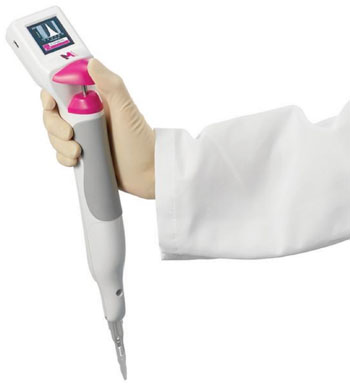Genotyping Performed by FRET-PCR Without DNA Extraction
By LabMedica International staff writers
Posted on 07 Jul 2014
Blood samples are extensively used for the molecular diagnosis of many hematological diseases using a variety of techniques, based on the amplification of nucleic acids.Posted on 07 Jul 2014
Current methods for polymerase chain reaction (PCR) use purified genomic DNA, mostly isolated from total peripheral blood cells or white blood cells (WBC), which can be improved by a real-time fluorescence resonance energy transfer-based method for genotyping directly from blood cells.
Hematologists at the Hospital Universitari Son Espases (Palma de Mallorca, Spain) studied peripheral blood from 34 patients collected into tubes containing ethylenediaminetetraacetic acid (EDTA). Among the samples, they included a mixture of mutant alleles for patients suffering from thrombosis or hereditary hemochromatosis. Red blood cells (RBCs) were lysed and white blood cells (WBCs) isolated. A real-time PCR was then performed followed by a melting curve analysis for different genes including methylenetetrahydrofolate reductase (MTHFR), hemochromatosis (HFE), coagulation factor V Leiden (F5), prothrombin factor two (F2) and coagulation factor XII (F12).
The real time PCR was performed on the LightCycler 2.0 Instrument (Roche Diagnostics Corporation, Indianapolis, IN, USA). In order to standardize the samples for the real-time PCR reaction, cells were counted in a Scepter 2.0 Automated Cell Counter (Merck Millipore, Billerica, MA, USA) and adjusted to 5×106 cells/mL. After testing 34 samples comparing the real-time crossing point (CP) values between 5×106 WBC/mL and 20 ng/µL of purified DNA, the results for F5 Leiden were as follows: CP mean value for WBC was 29.26 ± 0.57 versus purified DNA 24.79 ± 0.56. There was an observed delay of about four cycles when PCR was performed from WBC instead of DNA.
The authors concluded that their protocol obviates the DNA purification stage, thereby saving time and resources. Furthermore, since the manipulation performed on the sample is minimal, it may decrease the risk of contamination. As they reported the results from a variety of genes, they contend that their protocol will be suitable for the genotyping of almost any inherited polymorphism. The study was published on June 25, 2014, in the Journal of Blood Medicine.
Related Links:
Hospital Universitari Son Espases
Roche Diagnostics Corporation
Merck Millipore















